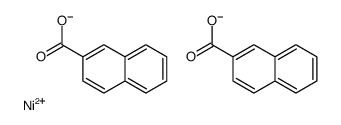61788-71-4
| Name | naphthalene-2-carboxylate,nickel(2+) |
|---|---|
| Synonyms |
Naphthenic acids,nickel salts
EINECS 263-000-1 MFCD00147723 naphthalene-2-carboxylate |
| Melting Point | > 100ºC |
|---|---|
| Molecular Formula | C22H14NiO4 |
| Molecular Weight | 401.03800 |
| Flash Point | combustible |
| Exact Mass | 400.02500 |
| PSA | 80.26000 |
| LogP | 2.40660 |
| Water Solubility | Insoluble in water. |
|
Section 1: Product Identification Chemical Name:Nickel (II) naphthenate, approx. 60% in toluene (6-8% Ni) CAS Registry Number:61788-71-4 Formula:Ni salt of napthenic acid EINECS Number:none Chemical Family:metal carboxylate Synonym:Naphthenic acid, nickel salt, in methyl benzene
Section 2: Composition and Information on Ingredients IngredientCAS NumberPercentACGIH (TWA)OSHA (PEL) Title Compound61788-71-460%0.2mg/m3 (as Ni)1mg/m3 (as Ni) toluene108-88-340%50ppm300ppm (ceiling Section 3: Hazards Identification Harmful by inhalation and if swallowed. Irritating to skin, eyes and respiratory tract. Possible risk of irreversible Emergency Overview: effects. May cause cancer. Primary Routes of Exposure:Ingestion, eyes, inhalation, skin Eye Contact:Causes moderate irritation of the eyes. Skin Contact:Causes mild irritation of the skin. Prolonged contact with nickel salts may lead to dermatitis. Harmful by inhalation. Vapor is irritating to the nose, mucous membranes and respiratory tract and cause Inhalation: headache, dizziness, and drowsiness. Harmful if swallowed. Ingestion may cause gastrointestinal distress, vomiting, convulsions, dizziness, Ingestion: weakness and drowsiness. Acute Health Affects:Harmful by inhalation and if swallowed. Irritating to skin, eyes and respiratory tract. Chronic toluene poisoning may result in bone marrow or liver injury. Prolonged exposure to nickel compounds Chronic Health Affects:may lead to skin irritation and dermatitis. May cause cancer and impair fertility. Possible risk of irreversible effects. NTP:Yes IARC:Yes OSHA:No SECTION 4: First Aid Measures Immediately flush the eyes with copious amounts of water for at least 10-15 minutes. A victim may need Eye Exposure: assistance in keeping their eye lids open. Get immediate medical attention. Wash the affected area with soap and water. Remove contaminated clothes if necessary. Seek medical Skin Exposure: assistance if irritation persists. Remove the victim to fresh air. Closely monitor the victim for signs of respiratory problems, such as difficulty Inhalation: in breathing, coughing, wheezing, or pain. In such cases seek immediate medical assistance. Seek medical attention immediately. Keep the victim calm. Do not induce vomiting as serious lung damage Ingestion: can result if aspirated. SECTION 5: Fire Fighting Measures Flash Point:40 °F(toluene) Autoignition Temperature:997 °F(toluene) Explosion Limits:1-7% in air (Toluene) Extinguishing Medium:carbon dioxide, dry powder or foam If involved in a fire, fire fighters should be equipped with a NIOSH approved positive pressure self-contained Special Fire Fighting Procedures: breathing apparatus and full protective clothing. Hazardous Combustion andIf involved in a fire this material may emit toxic organic fumes. Decomposion Products: Unusual Fire or Explosion Hazards: Flammable material at elevated temperatures. Formation of explosive air/ vapor mixtures is possible. SECTION 6: Accidental Release Measures Eliminate all ignition sources. Small spills may be adsorbed into diatomaceous earth, sand, or other suitable Spill and Leak Procedures: adsorbent, and swept up. SECTION 7: Handling and Storage Handling and Storage:Store in a tightly sealed container and store in a cool place. Handle in a well ventilated area. SECTION 8: Exposure Controls and Personal Protection Eye Protection:Always wear approved safety glasses when handling a chemical substance in the laboratory. Skin Protection:Wear appropriate chemical resistant gloves and protective clothing. Ventilation:Material may form a vapor. If possible, handle the material in an efficient fume hood. If ventilation is not available a respirator should be worn. The use of respirators requires a Respirator Respirator: Protection Program to be in compliance with 29 CFR 1910.134. Ventilation:Material may form a vapor. If possible, handle the material in an efficient fume hood. Additional Protection:No additional protection required. SECTION 9: Physical and Chemical Properties Color and Form:viscous liq. Molecular Weight:not applicable Melting Point:no data Boiling Point:no data Vapor Pressure:not applicable Specific Gravity:no data Odor:organic odor Solubility in Water:insoluble SECTION 10: Stability and Reactivity Stability:air and moisture stable liquid Hazardous Polymerization:no hazardous polymerization Conditions to Avoid:Keep away from heat and ignition sources including open flame and electrostatic discharge. Incompatibility:oxidizing agents Decomposition Products:Carbon dioxide, carbon monoxide, organic vapors, and metal oxides and carbonates. SECTION 11: Toxicological Information No information available in the RTECS files for title compound. Toluene: Oral (human) LDLo: 50 mg/kg; RTECS Data:Inhalation (human) TCLo: 200 ppm; Inhalation (human) TCLo 100 ppm; Oral (rat) LD50: 636 mg/Kg; Inhalation (rat) LC50:49gm/m3/4H; Intraperitoneal (rat) LD50:1332mg/Kg; Oral (rat) TDLo(reproductive): 7280 mg/Kg. Carcinogenic Effects:Carcinogen (as Ni) Mutagenic Effects:Toluene: Mutagen Tetratogenic Effects:Toluene: Reproductive effector SECTION 12: Ecological Information Ecological Information:No information available SECTION 13: Disposal Considerations Disposal:Dispose of according to local, state and federal regulations. SECTION 14: Transportation Shipping Name (CFR):Flammable liquids, N.O.S. Hazard Class (CFR):3 Additional Hazard Class (CFR):NA Packaging Group (CFR):III UN ID Number (CFR):UN# 1993 Shipping Name (IATA):Flammable liquid, N.O.S. Hazard Class (IATA):3 Additional Hazard Class (IATA):NA Packaging Group (IATA):III UN ID Number (IATA):UN# 1993 SECTION 15: Regulatory Information TSCA:Listed in the TSCA inventory. SARA (Title 313):Title compound: See Category Code N495 for reporting. Second Ingredient:Toluene (CAS# 108-88-3): listed TSCA; Listed SARA 313 SECTION 16 - ADDITIONAL INFORMATION N/A |
